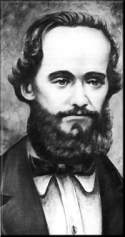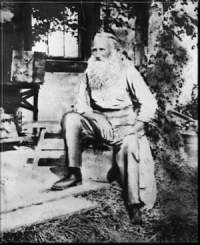|
A BRIEF HISTORY OF BEAVER ISLAND The history of Beaver Island can be roughly divided into three periods: Indian, Mormon, and Irish. Little is known about the early Indian inhabitants. The first traces, which were found along Angeline's Bluff, date back 4500 years, which is still 5000 years after a stubborn limestone lip scraped rocks and sediment from the belly of a passing glacier to form Beaver Island. The oldest artifacts found in any concentration are from 1200 to 500 years ago, but the Indians who used them have vanished. They were gone when the Ojibways arrived, although the Ojibways, according to legend, harvested their abandoned fields. The Ojibways stayed to greet the first white trappers and traders. In 1836 they signed a treaty with the U.S.A. An unsubstantiated but deeply ingrained local tradition is that between the 1640's and the 1680's the French established a colony on the island which they named "Isle du Castor." Beaver's waters were rich in fish. In the early 1830's some fishermen and a few merchants took advantage of the excellent natural harbor to establish a small village at what came to be called Whiskey Point. They fished from small sailboats and traded with the Indians for more fish, which they salted and shipped away. In the late 1830's the North West Trading Company built a post on the north shore of Beaver Harbor. Boats plying Lake Michigan began stopping regularly at Beaver to refuel, creating many jobs cutting cordwood. The community in the harbor and a second at Cable's Bay thrived. During the 1840's the population of Beaver grew to a few hundred. In 1845 the land was surveyed and in 1848 it was first put up for sale. Sixty ships entered Beaver Harbor in the summer of that year.
The Mormon people were hardworking and industrious, if a little gullible. They built roads and farms which are still in use, put up sturdy buildings which outlasted them by a hundred years, and started the first daily newspaper north of Grand Rapids. Their heads were filled with plans they weren't here long enough to accomplish. Their leader, a flamboyant, magnetic, red-bearded lawyer elected to the State Legislature by his people, appropriated land, claimed to receive divine commands, had himself crowned king and began taking additional wives. In 1856, with his kingdom of over 2000 torn with strife, he was fatally shot by two disgruntled former followers. Within weeks Strang's flock was driven away and scattered. Land speculators began buying chunks of Beaver and reselling portions of them to the fishermen who'd been forced to camp on the other islands. Some of these fishermen had been driven from their Beaver homes by the Mormons a few years earlier. They eagerly relocated on Beaver in 1856 and '57. It happened that many of them were Irish. These Irish fishermen enjoyed the prosperity of ready made farms, cheap land, and abundantly stocked fishing grounds. They passed the word to their friends, either working in America's mines or starving back in Ireland. Their friends decided to join them. The Irish community prospered and grew in the 1860's, 70's, and 80's. In the 1890's over 100 fishing boats docked at St. James. A life-saving station was started at Whiskey Point which later became one of the two island Coast Guard stations. When the century changed there were about 2000 Beaver Islanders, many of them second- generation Irish immigrants. Life was good. Early in the 20th century the Beaver Island Lumber Company was formed. It far surpassed any of the earlier logging operations on the island. It laid track for a narrow-gauge railroad along the gravel bed which had been a beach when lake waters were much higher and which is now the West Side Road. At the town end of its line it built a large mill and a dock extending 500' into the bay. By 1914 the operation was completed. The following year they pulled up the track. Religion has had a strong influence on the island since Bishop Baraga crossed to it in a canoe to baptize some of the natives he found in a village near Indian Point in 1832. At one time two Catholic Churches served the island, one of which was moved from Four Corners to town in 1957. There were also churches on Garden and on High.
When the Depression seized the country Beaver was relatively protected by a belt of whitefish and lake trout. After WWII the fish gave out from a combination of overfishing and the lamprey eel. Then the sons and daughters of third-generation Beaver Islanders were forced to leave for work. The population slipped to 500 in 1950 and to about 150 a decade later. Then in the mid-1960's the island was discovered again by vacationers with boats, jeeps, backpacks, and cameras. They revived a dying economy. New motels were built and businesses started or enlarged as tourism became the economic base. | ||
 In 1847 James Jesse Strang founded a small Mormon colony near the trading post. From having a handful of people who were barely tolerated by the rough fishermen it quickly grew until in 1850 it outnumbered the "gentiles." By 1852 the non-Mormons were crowded off the island.
In 1847 James Jesse Strang founded a small Mormon colony near the trading post. From having a handful of people who were barely tolerated by the rough fishermen it quickly grew until in 1850 it outnumbered the "gentiles." By 1852 the non-Mormons were crowded off the island.  In 1893 Feodor Protar moved into a small cabin near the end of Sloptown Road. He was a troubled and secretive émigré from Russia who dispensed medical help to the islanders without charge for the 32 years he was here. His benevolence earned him the title of Doctor Protar.
In 1893 Feodor Protar moved into a small cabin near the end of Sloptown Road. He was a troubled and secretive émigré from Russia who dispensed medical help to the islanders without charge for the 32 years he was here. His benevolence earned him the title of Doctor Protar.